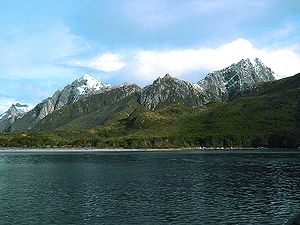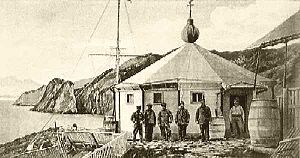
Isla de los Estados
Encyclopedia


Argentina
Argentina , officially the Argentine Republic , is the second largest country in South America by land area, after Brazil. It is constituted as a federation of 23 provinces and an autonomous city, Buenos Aires...
portion
Tierra del Fuego Province (Argentina)
Tierra del Fuego is an Argentine province entirely separated from mainland Argentina by the Strait of Magellan. It includes:* The eastern part of the Isla Grande of Tierra del Fuego archipelago and the Staten Island.* Argentina's claims to the Falkland Islands and to...
of Tierra del Fuego
Tierra del Fuego
Tierra del Fuego is an archipelago off the southernmost tip of the South American mainland, across the Strait of Magellan. The archipelago consists of a main island Isla Grande de Tierra del Fuego divided between Chile and Argentina with an area of , and a group of smaller islands including Cape...
, from which it is separated by the Le Maire Strait
Le Maire Strait
The Le Maire Strait is a sea passage between Isla de los Estados and the eastern extremity of the Argentine portion of Tierra del Fuego....
. It was named for the Netherlands States-General, and its original Dutch name was identical to that of the New York borough of Staten Island
Staten Island
Staten Island is a borough of New York City, New York, United States, located in the southwest part of the city. Staten Island is separated from New Jersey by the Arthur Kill and the Kill Van Kull, and from the rest of New York by New York Bay...
.
The island is administratively part of the Argentinian province of Tierra del Fuego, and of the department and city of Ushuaia
Ushuaia
Ushuaia may refer to the following:*Ushuaia, a city in Argentina.**Ushuaia Department, an administrative division**Ushuaia River**Ushuaia International Airport**Colegio Nacional de Ushuaia, National School of Ushuaia....
. It has been declared an "Ecological, Historic, and Tourist Provincial Reserve" ("Reserva provincial ecológica, histórica y turística"), with access limited to tours from Ushuaia. The only settlement is the Puerto Parry Naval Station, located in a deep and narrow fjord on the northern coast of the island. The naval station, created in 1978, is manned by a team of four marines on a 45-day rotation, in charge of monitoring environmental conservation, ship movement, and also to provide emergency assistance.
History
The first Europeans in the area were Jacob le MaireJacob Le Maire
Jacob Le Maire was a Dutch mariner who circumnavigated the earth in 1615-16. The strait between Tierra del Fuego and Isla de los Estados was named the Le Maire Strait in his honor, though not without controversy...
and Willem Schouten
Willem Schouten
Willem Cornelisz Schouten was a Dutch navigator for the Dutch East India Company. He was the first to sail the Cape Horn route to the Pacific Ocean.- Biography :Willem Cornelisz Schouten was born in c...
on December 25, 1615, who named it Country of the Lords of the State.
Le Maire and Schouten passed the Eendracht through a route south of the Straits of Magellan, a route now called the Strait of Le Maire. To his left Le Maire noted the land mass (unexplored) as Staten Landt, perhaps a portion of the great 'Southern Continent'? (The first European name for New Zealand was Staten Landt, the name given to it by the Dutch explorer Abel Tasman, who in 1642 became the first European to see the islands. Tasman assumed it was part of this 'Southern Continent')
Dutch captain Hendrik Brouwer
Hendrik Brouwer
Hendrik Brouwer was a Dutch explorer, admiral, and colonial administrator both in Japan and the Dutch East Indies....
sighted it in 1643. Argentine pilot
Maritime pilot
A pilot is a mariner who guides ships through dangerous or congested waters, such as harbours or river mouths. With the exception of the Panama Canal, the pilot is only an advisor, as the captain remains in legal, overriding command of the vessel....
Luis Piedra Buena constructed a shelter near Port Cook in 1862, and built a small seal oil extraction facility on the island.
The San Juan del Salvamento was inaugurated on May 25, 1884 by Comodoro Augusto Lasserre, and functioned until 1899. The lighthouse, better known as Faro del fin del mundo ("Lighthouse at the end of the world"), is said to have inspired Jules Verne
Jules Verne
Jules Gabriel Verne was a French author who pioneered the science fiction genre. He is best known for his novels Twenty Thousand Leagues Under the Sea , A Journey to the Center of the Earth , and Around the World in Eighty Days...
for his book The Lighthouse at the End of the World
Le Phare du bout du monde
The Lighthouse at the End of the World is an adventure novel by French author Jules Verne. Verne wrote the first draft in 1901. It was first published posthumously in 1905. The plot of the novel involves piracy in the South Atlantic during the mid-19th century, with a theme of survival in extreme...
, published in 1905.
A military prison was set on the island, working from 1899 to 1902, when it had to be moved to Tierra del Fuego after being compromised by the strong winds.
Geography
The island is approximately 65 kilometres (40 mi) long east-west, and 15 kilometres (9 mi) wide, with an area of 534 sqkm. The island is deeply indented by bays. Its highest point is 823 metres (2,700 ft), and is considered to be the last prominence of the AndesAndes
The Andes is the world's longest continental mountain range. It is a continual range of highlands along the western coast of South America. This range is about long, about to wide , and of an average height of about .Along its length, the Andes is split into several ranges, which are separated...
mountain range. It receives around 2000 millimetres (79 in) of rain per year.
The island is surrounded by minor islands and rocks, the largest being Isla Observatorio 6.5 kilometres (4.04 mi) north, with an area of 4 sqkm.

Flora and fauna
Isla de los Estados is covered with dense low forests of Nothofagus southern beech. The animal life is composed mainly of penguinPenguin
Penguins are a group of aquatic, flightless birds living almost exclusively in the southern hemisphere, especially in Antarctica. Highly adapted for life in the water, penguins have countershaded dark and white plumage, and their wings have become flippers...
s, orca
Orca
The killer whale , commonly referred to as the orca, and less commonly as the blackfish, is a toothed whale belonging to the oceanic dolphin family. Killer whales are found in all oceans, from the frigid Arctic and Antarctic regions to tropical seas...
s, seal
Earless seal
The true seals or earless seals are one of the three main groups of mammals within the seal superfamily, Pinnipedia. All true seals are members of the family Phocidae . They are sometimes called crawling seals to distinguish them from the fur seals and sea lions of the family Otariidae...
s, seagulls and cormorant
Cormorant
The bird family Phalacrocoracidae is represented by some 40 species of cormorants and shags. Several different classifications of the family have been proposed recently, and the number of genera is disputed.- Names :...
s, as well as the human-introduced deer
Deer
Deer are the ruminant mammals forming the family Cervidae. Species in the Cervidae family include white-tailed deer, elk, moose, red deer, reindeer, fallow deer, roe deer and chital. Male deer of all species and female reindeer grow and shed new antlers each year...
and goat
Goat
The domestic goat is a subspecies of goat domesticated from the wild goat of southwest Asia and Eastern Europe. The goat is a member of the Bovidae family and is closely related to the sheep as both are in the goat-antelope subfamily Caprinae. There are over three hundred distinct breeds of...
s. The island is the location of one of the more southerly Atlantic
Atlantic Ocean
The Atlantic Ocean is the second-largest of the world's oceanic divisions. With a total area of about , it covers approximately 20% of the Earth's surface and about 26% of its water surface area...
breeding colonies of the Magellanic Penguin
Magellanic Penguin
The Magellanic Penguin, Spheniscus magellanicus, is a South American penguin, breeding in coastal Argentina, Chile and the Falkland Islands, with some migrating to Brazil where they are occasionally seen as far north as Rio de Janeiro. It is the most numerous of the Spheniscus penguins. Its nearest...
. As early as the last part of the 18th century, Isla de los Estados was used as a seal harvesting location.
External links
- Isla de los Estados - InterPatagonia.com
- Isla de los Estados reserve (Spanish)

